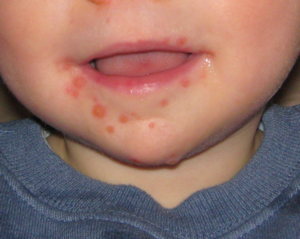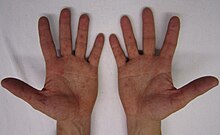Bolest ruku, nogu i usta — разлика између измена
. |
(нема разлике)
|
Верзија на датум 29. јун 2020. у 04:11
| Bolest ruku, nogu i usta | |
|---|---|
| Sinonimi | Enterovirusni vezikularni stomatitis sa egzantemom |
 | |
| Tipične lezije oko usta 11-mesečnog dečaka | |
| Specijalnosti | Infectious disease |
| Simptomi | Groznica, ravne mrlje ili izbočine koje mogu prerasti u plikove[1][2] |
| Komplikacije | Privremeni gubitank noktiju, virusni meningitis[3] |
| Vreme pojave | 3–6 nakon izlaganja[4] |
| Trajanje | 1 nedelja[5] |
| Uzroci | Koksaki virusi A16, Enterovirus 71[6] |
| Dijagnostički metod | Na osnovu simptoma, virusne kulture[7] |
| Prevencija | Pranje ruku[8] |
| Lečenje | Potporna njega[5] |
| Lekovi | Lekovi za bolovie kao što je ibuprofen[9] |
| Frekvencija | Kao izbijanja[1] |
Један корисник управо ради на овом чланку. Молимо остале кориснике да му допусте да заврши са радом. Ако имате коментаре и питања у вези са чланком, користите страницу за разговор.
Хвала на стрпљењу. Када радови буду завршени, овај шаблон ће бити уклоњен. Напомене
|
Bolest ruku, nogu i usta (engl. Hand, foot, and mouth disease - HFMD) je česta infekcija uzrokovana grupom virusa.[10] It typically begins with a fever and feeling generally unwell.[10] This is followed a day or two later by flat discolored spots or bumps that may blister, on the hands, feet and mouth and occasionally buttocks and groin.[1][2][11] Signs and symptoms normally appear 3–6 days after exposure to the virus.[4] The rash generally resolves on its own in about a week.[5] Fingernail and toenail loss may occur a few weeks later, but they will regrow with time.[3]
The viruses that cause HFMD are spread through close personal contact, through the air from coughing and the feces of an infected person.[8] Contaminated objects can also spread the disease.[8] Coxsackievirus A16 is the most common cause, and enterovirus 71 is the second-most common cause.[6] Other strains of coxsackievirus and enterovirus can also be responsible.[6][12] Some people may carry and pass on the virus despite having no symptoms of disease.[10] Other animals are not involved.[8] Diagnosis can often be made based on symptoms.[7] Occasionally, a throat or stool sample may be tested for the virus.[7]
Handwashing may prevent spread, and those infected should not go to work, daycare or school.[8] No antiviral medication or vaccine is available, but development efforts are underway.[13][14] Most cases require no specific treatment.[5] Simple pain medication such as ibuprofen or numbing mouth gel may be used.[9] Occasionally, intravenous fluids are given to children who are unable to drink enough.[9] Rarely, viral meningitis or encephalitis may complicate the disease.[3]
HFMD occurs in all areas of the world.[15] It often occurs in small outbreaks in nursery schools or kindergartens.[1] Large outbreaks have been occurring in Asia since 1997.[15] It usually occurs during the spring, summer and fall months.[15] Typically it occurs in children less than five years old but can occasionally occur in adults.[1][10] HFMD should not be confused with foot-and-mouth disease (also known as hoof-and-mouth disease), which mostly affects livestock.[16]
Znaci i simptomi
Common constitutional signs and symptoms of the HFMD include fever, nausea, vomiting, feeling tired, generalized discomfort, loss of appetite, and irritability in infants and toddlers. Skin lesions frequently develop in the form of a rash of flat discolored spots and bumps which may be followed by vesicular sores with blisters on palms of the hands, soles of the feet, buttocks, and sometimes on the lips.[17] The rash is rarely itchy for children,[4] but can be extremely itchy for adults. Painful facial ulcers, blisters, or lesions may also develop in or around the nose or mouth.[1][18][19] HFMD usually resolves on its own after 7–10 days.[18] Most cases of the disease are relatively harmless, but complications including encephalitis, meningitis, and paralysis that mimics the neurological symptoms of polio can occur.[20]
-
Rash on palms of the hands.
-
Rash on hand and feet of a 36-year-old man
-
Rash on the soles of a child's feet
Uzrok
The viruses that cause the disease are of the Picornaviridae family. Coxsackievirus A16 is the most common cause of HFMD.[6] Enterovirus 71 (EV-71) is the second-most common cause.[6] Many other strains of coxsackievirus and enterovirus can also be responsible.[6][12]
Transmisija
HFMD is highly contagious and is transmitted by nasopharyngeal secretions such as saliva or nasal mucus, by direct contact, or by fecal-oral transmission. It is possible to be infectious for days to weeks after the symptoms have resolved.[8]
Child care settings are the most common places for HFMD to be contracted because of the bathroom training, diaper changes, and that children often put their hands into their mouths.[19] Children who do not attend a preschool or kindergarten were found to be more susceptible to the disease.[21] HFMD is contracted through nose and throat secretions such as saliva, sputum, nasal mucus and as well as fluid in blisters, and stool.[21]
Dijagnoza
A diagnosis usually can be made by the presenting signs and symptoms alone.[18] If the diagnosis is unclear, a throat swab or stool specimen may be taken to identify the virus by culture.[18] The common incubation period (the time between infection and onset of symptoms) ranges from three to six days.[4] Early detection of HFMD is important in preventing an outbreak in the pediatric population.[22]
Prevencija
Preventive measures include avoiding direct contact with infected individuals (including keeping infected children home from school), proper cleaning of shared utensils, disinfecting contaminated surfaces, and proper hand hygiene. These measures have been shown to be effective in decreasing the transmission of the viruses responsible for HFMD.[18][23]
Protective habits include hand washing and disinfecting surfaces in play areas.[21] Breast-feeding has also shown to decrease rates of severe HFMD, though does not reduce the risk for the infection of the disease.[21]
Vakcina
A vaccine known as the EV71 vaccine is available to prevent HFMD in China ажурирано: децембар 2015.[ажурирање].[24] No vaccine is currently available in the United States.[23]
Istorija
HFMD cases were first described clinically in Canada and New Zealand in 1957.[18] The disease was termed "Hand Foot and Mouth Disease", by Thomas Henry Flewett, after a similar outbreak in 1960.[25][26]
Reference
- ^ а б в г д ђ Kaminska, K; Martinetti, G; Lucchini, R; Kaya, G; Mainetti, C (2013). „Coxsackievirus A6 and Hand, Foot, and Mouth Disease: Three Case Reports of Familial Child-to-Immunocompetent Adult Transmission and a Literature Review”. Case Reports in Dermatology. 5 (2): 203—209. PMC 3764954
 . PMID 24019771. doi:10.1159/000354533.
. PMID 24019771. doi:10.1159/000354533.
- ^ а б Ooi, MH; Wong, SC; Lewthwaite, P; Cardosa, MJ; Solomon, T (2010). „Clinical features, diagnosis, and management of enterovirus 71”. Lancet Neurology. 9 (11): 1097—1105. PMID 20965438. doi:10.1016/S1474-4422(10)70209-X.
- ^ а б в „Hand, Foot, and Mouth Disease (HFMD) Complications”. CDC. 18. 8. 2015. Архивирано из оригинала 11. 5. 2016. г. Приступљено 14. 5. 2016.
- ^ а б в г Hoy, NY; Leung, AK; Metelitsa, AI; Adams, S (2012). „New concepts in median nail dystrophy, onychomycosis, and hand, foot and mouth disease nail pathology”. ISRN Dermatology. 2012 (680163): 680163. PMC 3302018
 . PMID 22462009. doi:10.5402/2012/680163.
. PMID 22462009. doi:10.5402/2012/680163.
- ^ а б в г Longo, Dan L. (2012). Harrison's Principles of Internal Medicine. (18th изд.). New York: McGraw-Hill. ISBN 978-0-07174889-6.
- ^ а б в г д ђ Repass GL, Palmer WC, Stancampiano FF (септембар 2014). „Hand, foot, and mouth disease: Identifying and managing an acute viral syndrome”. Cleve Clin J Med. 81 (9): 537—43. PMID 25183845. doi:10.3949/ccjm.81a.13132
 .
.
- ^ а б в „Diagnosis”. CDC. 18. 8. 2015. Архивирано из оригинала 14. 5. 2016. г. Приступљено 15. 5. 2016.
- ^ а б в г д ђ „Causes & Transmission”. CDC. 18. 8. 2015. Архивирано из оригинала 14. 5. 2016. г. Приступљено 15. 5. 2016.
- ^ а б в „Prevention & Treatment”. CDC. 18. 8. 2015. Архивирано из оригинала 15. 5. 2016. г. Приступљено 15. 5. 2016.
- ^ а б в г „Hand Foot and Mouth Disease”. CDC. 18. 8. 2015. Архивирано из оригинала 16. 5. 2016. г. Приступљено 14. 5. 2016.
- ^ Frydenberg, A; Starr, M (август 2003). „Hand, foot and mouth disease.”. Australian Family Physician. 32 (8): 594—5. PMID 12973865.
- ^ а б Li, Y; Zhu, R; Qian, Y; Deng, J (2012). „The characteristics of blood glucose and WBC counts in peripheral blood of cases of hand foot and mouth disease in China: a systematic review”. PLOS One. 7 (1): e29003. Bibcode:2012PLoSO...729003L. PMC 3250408
 . PMID 22235257. doi:10.1371/journal.pone.0029003.
. PMID 22235257. doi:10.1371/journal.pone.0029003.
- ^ Pourianfar HR, Grollo L (фебруар 2014). „Development of antiviral agents toward enterovirus 71 infection”. J Microbiol Immunol Infect. 48 (1): 1—8. PMID 24560700. doi:10.1016/j.jmii.2013.11.011
 .
.
- ^ Fang, Chih-Yeu; Liu, Chia-Chyi (2018). „Recent development of enterovirus A vaccine candidates for the prevention of hand, foot, and mouth disease”. Expert Review of Vaccines. 17 (9): 819—831. ISSN 1744-8395. PMID 30095317. doi:10.1080/14760584.2018.1510326.
- ^ а б в „Outbreaks”. CDC. 18. 8. 2015. Архивирано из оригинала 17. 5. 2016. г. Приступљено 15. 5. 2016.
- ^ „Foot and Mouth Disease update: further temporary control zone established in Surrey”. Defra. 2007-08-14. Архивирано из оригинала 2007-09-27. г. Приступљено 2007-08-14.
- ^ Huang, CC; Liu, CC; Chang, YC; Chen, CY; Wang, ST; Yeh, TF (23. 9. 1999). „Neurologic complications in children with enterovirus 71 infection.”. The New England Journal of Medicine. 341 (13): 936—42. PMID 10498488. doi:10.1056/nejm199909233411302.
- ^ а б в г д ђ Wang, Jing (21. 8. 2017). „Epidemiological characteristics of hand, foot, and mouth disease in Shandong, China, 2009–2016”. Scientific Reports. 7 (8900): 8900. Bibcode:2017NatSR...7.8900W. PMC 5567189
 . PMID 28827733. doi:10.1038/s41598-017-09196-z.
. PMID 28827733. doi:10.1038/s41598-017-09196-z.
- ^ а б „Hand, Foot and Mouth Disease: Signs & Symptoms”. mayoclinic.com. The Mayo Clinic. Архивирано из оригинала 1. 5. 2008. г. Приступљено 5. 5. 2008.
- ^ „Hand, Foot and Mouth Disease (HFMD)”. WHO Western Pacific Region (на језику: енглески). Приступљено 2017-11-06.
- ^ а б в г Koh, Wee Ming; Bogich, Tiffany; Siegel, Karen; Jin, Jing; Chong, Elizabeth Y.; Tan, Chong Yew; Chen, Mark Ic; Horby, Peter; Cook, Alex R. (октобар 2016). „The Epidemiology of Hand, Foot and Mouth Disease in Asia: A Systematic Review and Analysis”. The Pediatric Infectious Disease Journal. 35 (10): e285—300. ISSN 1532-0987. PMC 5130063
 . PMID 27273688. doi:10.1097/INF.0000000000001242.
. PMID 27273688. doi:10.1097/INF.0000000000001242.
- ^ Omaña-Cepeda, Carlos; Martínez-Valverde, Andrea; del Mar Sabater- Recolons, María; Jané-Salas, Enric; Marí-Roig, Antonio; López-López, José (2016-03-15). „A literature review and case report of hand, foot and mouth disease in an immunocompetent adult”. BMC Research Notes. 9: 165. ISSN 1756-0500. PMC 4791924
 . PMID 26975350. doi:10.1186/s13104-016-1973-y.
. PMID 26975350. doi:10.1186/s13104-016-1973-y.
- ^ а б „Hand, Foot and Mouth Disease”. Prevention and Treatment. Centers for Disease Control and Prevention. 2013. Архивирано из оригинала 17. 10. 2013. г. Приступљено 18. 10. 2013.
- ^ Mao, QY; Wang, Y; Bian, L; Xu, M; Liang, Z (мај 2016). „EV71 vaccine, a new tool to control outbreaks of hand, foot and mouth disease (HFMD).”. Expert Review of Vaccines. 15 (5): 599—606. PMID 26732723. doi:10.1586/14760584.2016.1138862.
- ^ Alsop J, Flewett TH, Foster JR (децембар 1960). „"Hand-foot-and-mouth disease" in Birmingham in 1959”. British Medical Journal. 2 (5214): 1708—11. PMC 2098292
 . PMID 13682692. doi:10.1136/bmj.2.5214.1708.
. PMID 13682692. doi:10.1136/bmj.2.5214.1708.
- ^ Flewett TH, Warin RP, Clarke SK (јануар 1963). „'Hand, foot, and mouth disease' associated with Coxsackie A5 virus”. Journal of Clinical Pathology. 16: 53—5. PMC 480485
 . PMID 13945538. doi:10.1136/jcp.16.1.53.
. PMID 13945538. doi:10.1136/jcp.16.1.53.
Spoljašnje veze
| Klasifikacija | |
|---|---|
| Spoljašnji resursi |
 Медији везани за чланак Bolest ruku, nogu i usta на Викимедијиној остави
Медији везани за чланак Bolest ruku, nogu i usta на Викимедијиној остави Новости везане за чланак Bolest ruku, nogu i usta на Викиновостима
Новости везане за чланак Bolest ruku, nogu i usta на Викиновостима



